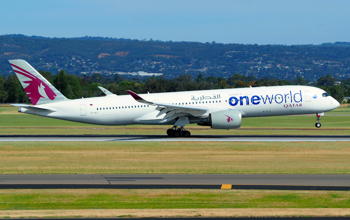Background Information.
The first Airbus A350 design was proposed by Airbus in 2004, in response to the Boeing 787 Dreamliner. It would have been a development of the Airbus A330 with composite wings and new engines. As market support was inadequate, in 2006 Airbus switched to a clean-sheet "XWB" (eXtra Wide Body) design, powered by Rolls-Royce Trent XWB turbofan engines.
The A350 XWB is the first Airbus mostly made of carbon fibre reinforced polymer. It has a new fuselage designed around a nine-abreast economy cross-section, up from the eight-abreast seating in the A330/A340 aircraft. It has a common type rating with the A330. The Airbus A350 is built in two variants. The A350-900 typically carries 300 to 350 passengers over a 15,000 kilometres (8,100 nautical miles) range and has a 280-tonne (617,300-pound) maximum take-off weight (MTOW). The Airbus A350-1000 is a longer version and accommodates 350 to 410 passengers, with a maximum range of 16,100 km (8,700 nmi) and a 319 tonne (703,200 lb) MTOW. It is supported by two 6-wheel main landing gear trucks (the -900 has four).
The Airbus A350 was a new design with a wider fuselage cross-section, allowing seating arrangements ranging from an eight-abreast low-density premium economy layout to a ten-abreast high-density seating configuration for a maximum seating capacity of 440 - 475 depending on the variant. The A330 and previous proposals of the A350 would only have been able to accommodate a maximum of eight seats per row. The 787 is typically configured for nine seats per row. The 777 accommodates nine or ten seats per row, with more than half of recent 777s being ten-abreast as the 777X will be. The A350 cabin is 12.7 cm (5.0 in) wider at the eye level of a seated passenger than the 787's cabin, and 28 cm (11 in) narrower than the Boeing 777's cabin. All A350 passenger models have a range of at least 8,000 nmi (14,816 km). The redesigned composite fuselage provides higher cabin pressure and humidity, and lower maintenance costs.
On December 01, 2006, the Airbus board of directors approved the industrial launch of the A350-800, -900, and -1000 variants. The delayed launch decision was a result of delays with the Airbus A380 and discussions on how to fund development. EADS CEO Thomas Enders stated that the A350 programme was not a certainty, citing EADS/Airbus's stretched resources. However, it was decided that the programme costs are to be borne mainly from cash-flow. First delivery for the A350-900 was scheduled for mid-2013, with the -800 and -1000 following some 12 and 24 months later, respectively.
New technical details of the A350 XWB were revealed at a press conference in December 2006. Chief operating officer, John Leahy indicated existing A350 contracts were being re-negotiated due to price increases compared to the original A350’s contracted price.
Design changes imposed a two-year delay into the original timetable and increased development costs from US$5.3 billion (€5.5 billion) to approximately US$10 billion (€9.7 billion). The total development cost for the A350 was estimated at US$15 billion by Reuters (€12 billion or £10 billion). The original mid-2013 delivery date of the A350 changed, as a longer than anticipated development forced Airbus to delay the final assembly and first flight of the aircraft to the third quarter of 2012 and second quarter of 2013 respectively. As a result, the flight test schedule was compressed from the original 15 months to 12 months. A350 programme chief Didier Evrard stressed that delays only affected the A350-900 while the -800 and -1000 schedules remained unchanged.
Airbus manufactured the first A350 structural components in December 2009. Production of the first fuselage barrel began in late 2010 at its production plant in Illescas, Spain. Construction of the first A350-900 centre wingbox was set to start in August 2010. The new composite rudder plant in China opened in early 2011. The forward fuselage of the first A350 was delivered to the final assembly plant in Toulouse on December 29, 2011. Final assembly of the first A350 static test model was started on April 05, 2012. Final assembly of the first prototype A350 was completed in December 2012.
The A350's maiden flight took place on June 14, 2013 from Toulouse Blagnac Airport. It flew for 4 hours, reaching Mach 0.8 at 25,000 feet after retracting the landing gear, thus starting a 2,500 hours of flight testing. Costs for developing the aircraft were estimated at €11 billion (US$15 billion or £9.5 billion) in June 2013.
The second A350 (msn 02), underwent two-and-a-half weeks of climatic tests in the unique McKinley Climatic Laboratory at Eglin Air Force Base, Florida, in May 2014, and was subjected to multiple climatic and humidity settings from a high of 45 °C to as low as −40 °C.
The A350 received type certification from the European Aviation Safety Agency (EASA) on September 30, 2014. By October 15, 2014, EASA had approved the A350-900 for ETOPS 370, thus allowing it to fly more than six hours on one engine and making it the first airliner to be approved for ‘ETOPS Beyond 180 minutes’ before entry into service. Later that month Airbus received regulatory approval for a Common Type Rating for pilot training between the A350 XWB and A330. Type certification was awarded by the FAA on November 12, 2014.
